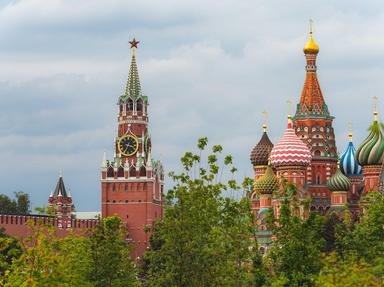Quiz Answer Key and Fun Facts
1. What "terrible" tsar, depicted here sharing a tender moment with the son he just murdered, became the first tsar of all Russia in 1547 and oversaw its early expansion eastward?
2. Feodor I became the second tsar of Russia in title, but it was in fact his advisor who held the power. When Feodor died in 1598 without an heir, that advisor became Russia's third tsar. What was the advisor's name?
3. The crisis of succession known as the Time of Troubles followed the death of Feodor I and left Russia in chaos for over a decade. It finally ended in 1613 with the rise of a new tsar, a relative of Feodor I. What tsar was the first Romanov, founding a dynasty that would rule Russia for over 300 years?
4. Russia had continued expanding eastward since the reign of Ivan the Terrible, and by the early 18th century it stretched from the Baltic Sea to the Pacific. What tsar, who began his reign in 1682, officially changed his title to "Emperor" in 1721 to reflect Russia's new power and prestige?
5. What tsar was born a German princess, became one of Russia's longest-reigning rulers, expanded its empire to the Black Sea and North America, and famously corresponded with Enlightenment thinkers like Voltaire?
6. Which "blessed" tsar defeated Napoleon in 1812 after changing Russia's position toward France multiple times?
7. Whose controversial reign as tsar began after the failed Decemberist Revolt, ended with the Crimean War, and was marked by totalitarianism, nationalism, antisemitism, and costly expansionism?
8. What tsar enacted liberal reforms including freeing the serfs, abolishing corporal punishment, and enacting local self-government reform before their assassination in 1881?
9. What tsar came to power after his father's assassination in 1881, reversing many of his dad's reforms? He ruled more autocratically, but is known as the Peacemaker for keeping Russia out of any major wars during his 14-year rule.
10. It was a fun run, but it just wasn't in the tsars. Who was the final emperor of Russia who fumbled his way into World War I and abdicated in 1917 amid the Russian Revolution?
Source: Author
JJHorner
This quiz was reviewed by FunTrivia editor
ponycargirl before going online.
Any errors found in FunTrivia content are routinely corrected through our feedback system.
